maintenance GENESIS GV80 2021 Repair Manual
[x] Cancel search | Manufacturer: GENESIS, Model Year: 2021, Model line: GV80, Model: GENESIS GV80 2021Pages: 632, PDF Size: 9.37 MB
Page 611 of 632

Maintenance
9-70
Corrosion protection
Protecting your vehicle from corrosion
By using the most advanced design
and construction practices to combat
corrosion, Genesis Branded Vehicle
produces vehicles of the highest quality.
However, this is only part of the job.
To achieve the long-term corrosion
resistance the owner’s cooperation and
assistance is also required.
Common causes of corrosion
The most common causes of corrosion
on your vehicle are:
• Road salt, dirt and moisture that is
allowed to accumulate underneath
the vehicle.
• Removal of paint or protective
coatings by stones, gravel, abrasion
or minor scrapes and dents which
leave unprotected metal exposed to
corrosion.High-corrosion areas
If you live in an area where your vehicle is
regularly exposed to corrosive materials,
corrosion protection is particularly
important. Some of the common causes
of accelerated corrosion are road salts,
dust control chemicals, ocean air and
industrial pollution.
Moisture breeds corrosion
Moisture creates the conditions in
which corrosion is most likely to occur.
For example, corrosion is accelerated
by high humidity, particularly when
temperatures are just above freezing. In
such conditions, the corrosive material is
kept in contact with the vehicle surfaces
by moisture that is slow to evaporate.
Mud is particularly corrosive because
it is slow to dry and holds moisture in
contact with the vehicle. Although the
mud appears to be dry, it can still retain
moisture and promote corrosion.
High temperatures can also accelerate
corrosion of parts that are not properly
ventilated so the moisture can be
dispersed. For all these reasons, it is
particularly important to keep your
vehicle clean and free of mud or
accumulations of other materials. This
applies not only to the visible surfaces
but particularly to the underside of the
vehicle.
Page 613 of 632

Maintenance
9-72
Interior Care
Interior general precautions
Prevent caustic solutions such as
perfume and cosmetic oil, from
contacting the interior parts because
they may cause damage or discoloration.
If they do contact the interior parts,
wipe them off immediately. See the
instructions for the proper way to clean
vinyl.
NOTICE
• Never allow water or other liquids
to come in contact with electrical/
electronic components inside the
vehicle as this may damage them.
• When cleaning leather products
(steering wheel, seats etc.), use
neutral detergents or low alcohol
content solutions. If you use high
alcohol content solutions or acid/
alkaline detergents, the color of the
leather may fade or the surface may
get stripped off.
Cleaning the upholstery and interior
trim
Vinyl (if equipped)
Remove dust and loose dirt from vinyl
with a whisk broom or vacuum cleaner.
Clean vinyl surfaces with a vinyl cleaner.
Fabric (if equipped)
Remove dust and loose dirt from
fabric with a whisk broom or vacuum
cleaner. Clean with a mild soap solution
recommended for upholstery or carpets.
Remove fresh spots immediately with
a fabric spot cleaner. If fresh spots do
not receive immediate attention, the
fabric can be stained and its color can be
affected. Also, its fire-resistant properties
can be reduced if the material is not
properly maintained.
NOTICE
Using anything but recommended
cleaners and procedures may affect the
fabric’s appearance and fire-resistant
properties.
Page 615 of 632
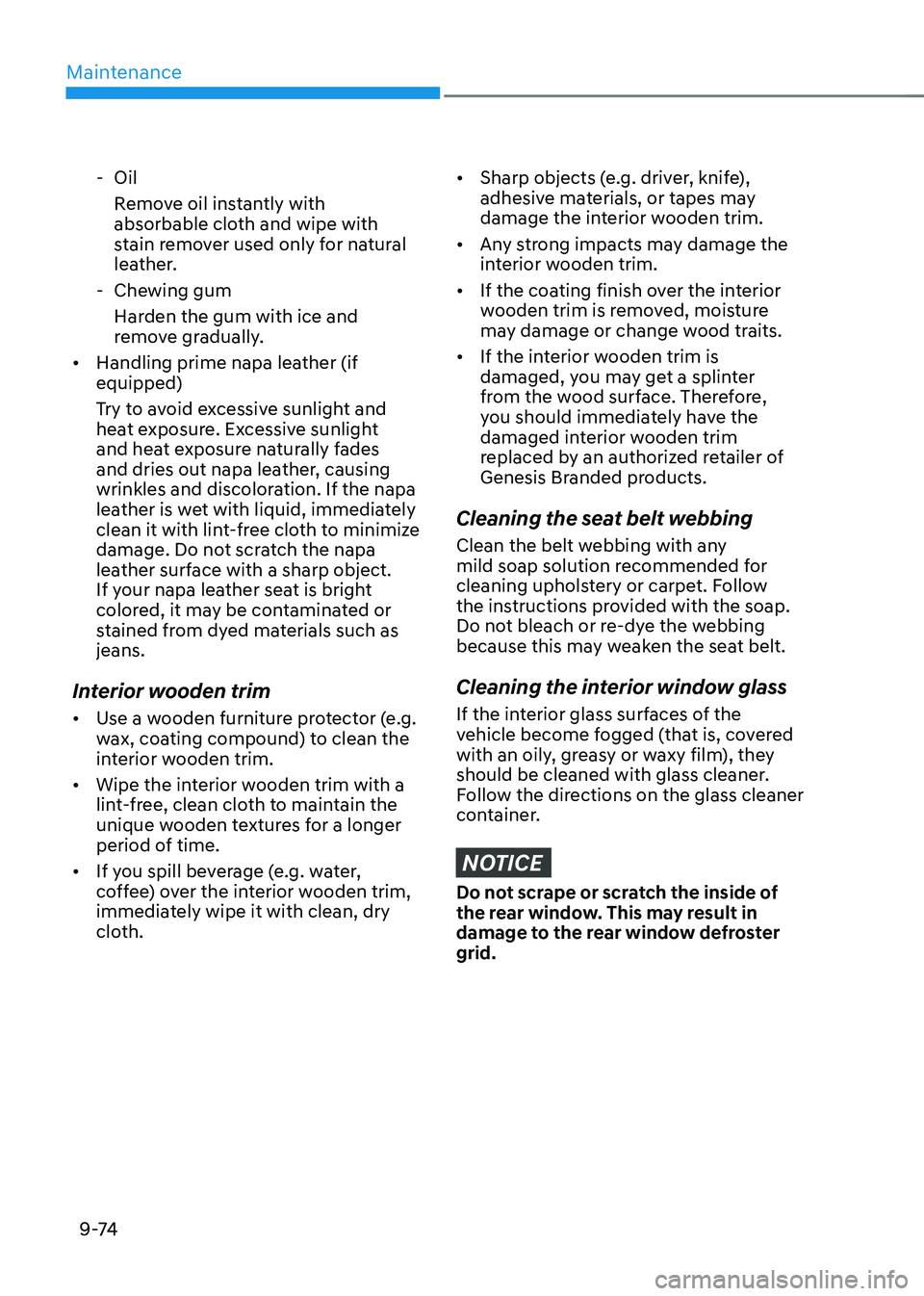
Maintenance
9 -74
-Oil
Remove oil instantly with
absorbable cloth and wipe with
stain remover used only for natural
leather.
-Chewing gum
Harden the gum with ice and
remove gradually.
• Handling prime napa leather (if
equipped)
Try to avoid excessive sunlight and
heat exposure. Excessive sunlight
and heat exposure naturally fades
and dries out napa leather, causing
wrinkles and discoloration. If the napa
leather is wet with liquid, immediately
clean it with lint-free cloth to minimize
damage. Do not scratch the napa
leather surface with a sharp object.
If your napa leather seat is bright
colored, it may be contaminated or
stained from dyed materials such as
jeans.
Interior wooden trim
• Use a wooden furniture protector (e.g.
wax, coating compound) to clean the
interior wooden trim.
• Wipe the interior wooden trim with a
lint-free, clean cloth to maintain the
unique wooden textures for a longer
period of time.
• If you spill beverage (e.g. water,
coffee) over the interior wooden trim,
immediately wipe it with clean, dry
cloth.
• Sharp objects (e.g. driver, knife),
adhesive materials, or tapes may
damage the interior wooden trim.
• Any strong impacts may damage the
interior wooden trim.
• If the coating finish over the interior
wooden trim is removed, moisture
may damage or change wood traits.
• If the interior wooden trim is
damaged, you may get a splinter
from the wood surface. Therefore,
you should immediately have the
damaged interior wooden trim
replaced by an authorized retailer of
Genesis Branded products.
Cleaning the seat belt webbing
Clean the belt webbing with any
mild soap solution recommended for
cleaning upholstery or carpet. Follow
the instructions provided with the soap.
Do not bleach or re-dye the webbing
because this may weaken the seat belt.
Cleaning the interior window glass
If the interior glass surfaces of the
vehicle become fogged (that is, covered
with an oily, greasy or waxy film), they
should be cleaned with glass cleaner.
Follow the directions on the glass cleaner
container.
NOTICE
Do not scrape or scratch the inside of
the rear window. This may result in
damage to the rear window defroster
grid.
Page 616 of 632
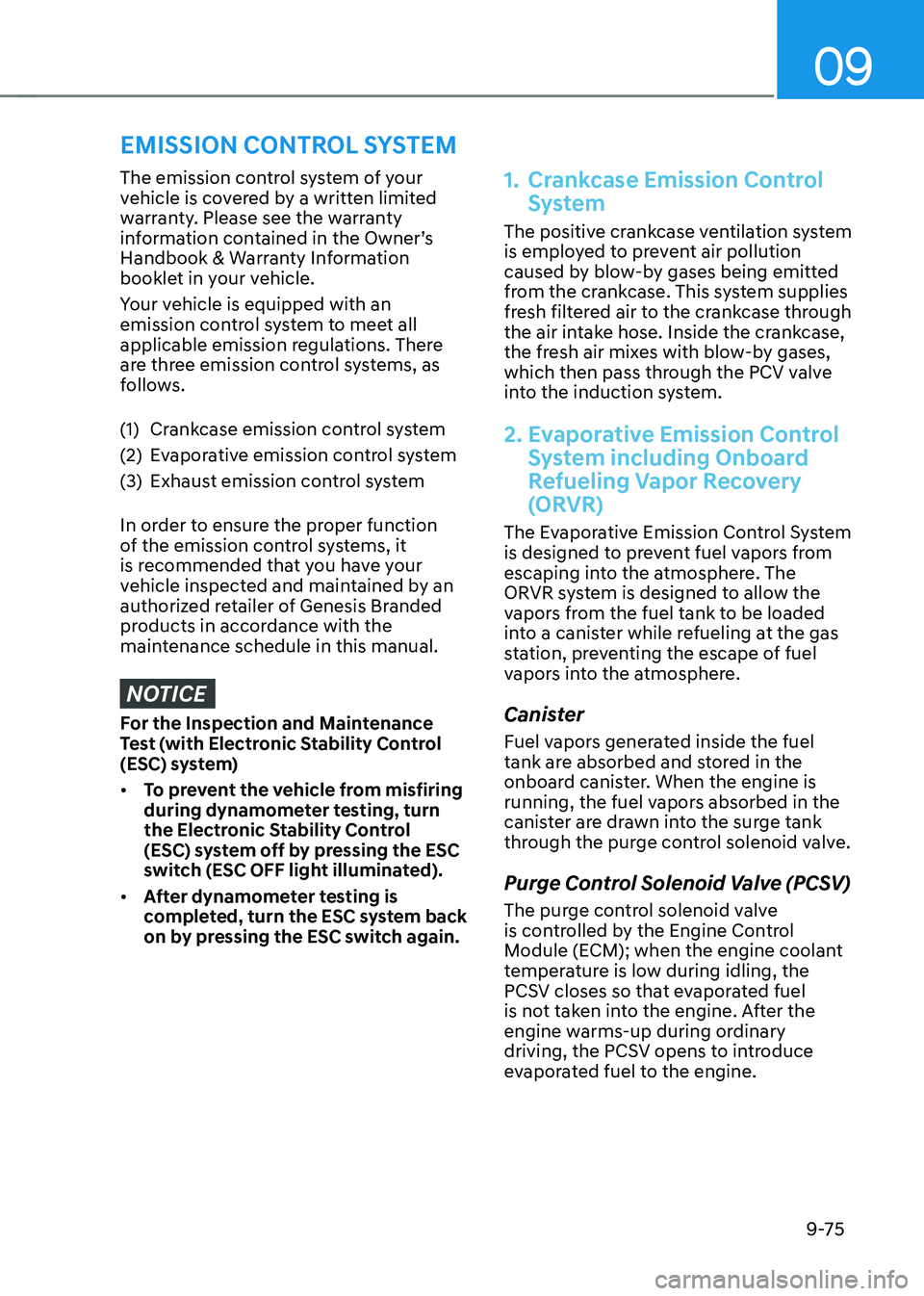
09
9-75
The emission control system of your
vehicle is covered by a written limited
warranty. Please see the warranty
information contained in the Owner’s
Handbook & Warranty Information
booklet in your vehicle.
Your vehicle is equipped with an
emission control system to meet all
applicable emission regulations. There
are three emission control systems, as
follows.
(1) Crankcase emission control system
(2) Evaporative emission control system
(3) Exhaust emission control system
In order to ensure the proper function
of the emission control systems, it
is recommended that you have your
vehicle inspected and maintained by an
authorized retailer of Genesis Branded
products in accordance with the
maintenance schedule in this manual.
NOTICE
For the Inspection and Maintenance
Test (with Electronic Stability Control
(ESC) system)
• To prevent the vehicle from misfiring
during dynamometer testing, turn
the Electronic Stability Control
(ESC) system off by pressing the ESC
switch (ESC OFF light illuminated).
• After dynamometer testing is
completed, turn the ESC system back
on by pressing the ESC switch again.
1. Crankcase Emission Control
System
The positive crankcase ventilation system
is employed to prevent air pollution
caused by blow-by gases being emitted
from the crankcase. This system supplies
fresh filtered air to the crankcase through
the air intake hose. Inside the crankcase,
the fresh air mixes with blow-by gases,
which then pass through the PCV valve
into the induction system.
2. Evaporative Emission Control
System including Onboard
Refueling Vapor Recovery
(ORVR)
The Evaporative Emission Control System
is designed to prevent fuel vapors from
escaping into the atmosphere. The
ORVR system is designed to allow the
vapors from the fuel tank to be loaded
into a canister while refueling at the gas
station, preventing the escape of fuel
vapors into the atmosphere.
Canister
Fuel vapors generated inside the fuel
tank are absorbed and stored in the
onboard canister. When the engine is
running, the fuel vapors absorbed in the
canister are drawn into the surge tank
through the purge control solenoid valve.
Purge Control Solenoid Valve (PCSV)
The purge control solenoid valve
is controlled by the Engine Control
Module (ECM); when the engine coolant
temperature is low during idling, the
PCSV closes so that evaporated fuel
is not taken into the engine. After the
engine warms-up during ordinary
driving, the PCSV opens to introduce
evaporated fuel to the engine.
EMISSION CONTROL SYSTEM
Page 617 of 632

Maintenance
9 -76
3. Exhaust Emission Control
System
The Exhaust Emission Control System is
a highly effective system which controls
exhaust emissions while maintaining
good vehicle performance.
When the engine starts or fails to start,
excessive attempts to restart the engine
may cause damage to the emission
system.
Engine exhaust (carbon monoxide)
precautions
• Carbon monoxide can be present
with other exhaust fumes. If you smell
exhaust fumes of any kind in your
vehicle, drive with all the windows
fully open. Have your vehicle checked
and repaired immediately.
WARNING
Engine exhaust gases contain carbon
monoxide (CO). Though colorless and
odorless, it is dangerous and could be
lethal if inhaled. Follow the instructions
on this page to avoid CO poisoning.
WARNING
CALIFORNIA PROPOSITION 65
WARNING
Engine exhaust and a wide variety of
automobile components and parts,
including components found in the
interior furnishings in a vehicle, contain
or emit chemicals known to the State
of California to cause cancer and
birth defects and reproductive harm.
In addition, certain fluids contained
in vehicles and certain products of
component wear contain or emit
chemicals known to the State of
California to cause cancer and birth
defects or other reproductive harm.
• Do not operate the engine in confined
or closed areas (such as garages) any
more than what is necessary to move
the vehicle in or out of the area.
• When the vehicle is stopped in an
open area for more than a short time
with the engine running, adjust the
ventilation system (as needed) to draw
outside air into the vehicle.
• Never sit in a parked or stopped
vehicle for any extended time with the
engine running.
• When the engine stalls or fails to
start, excessive attempts to restart
the engine may cause damage to the
emission control system.
Page 620 of 632
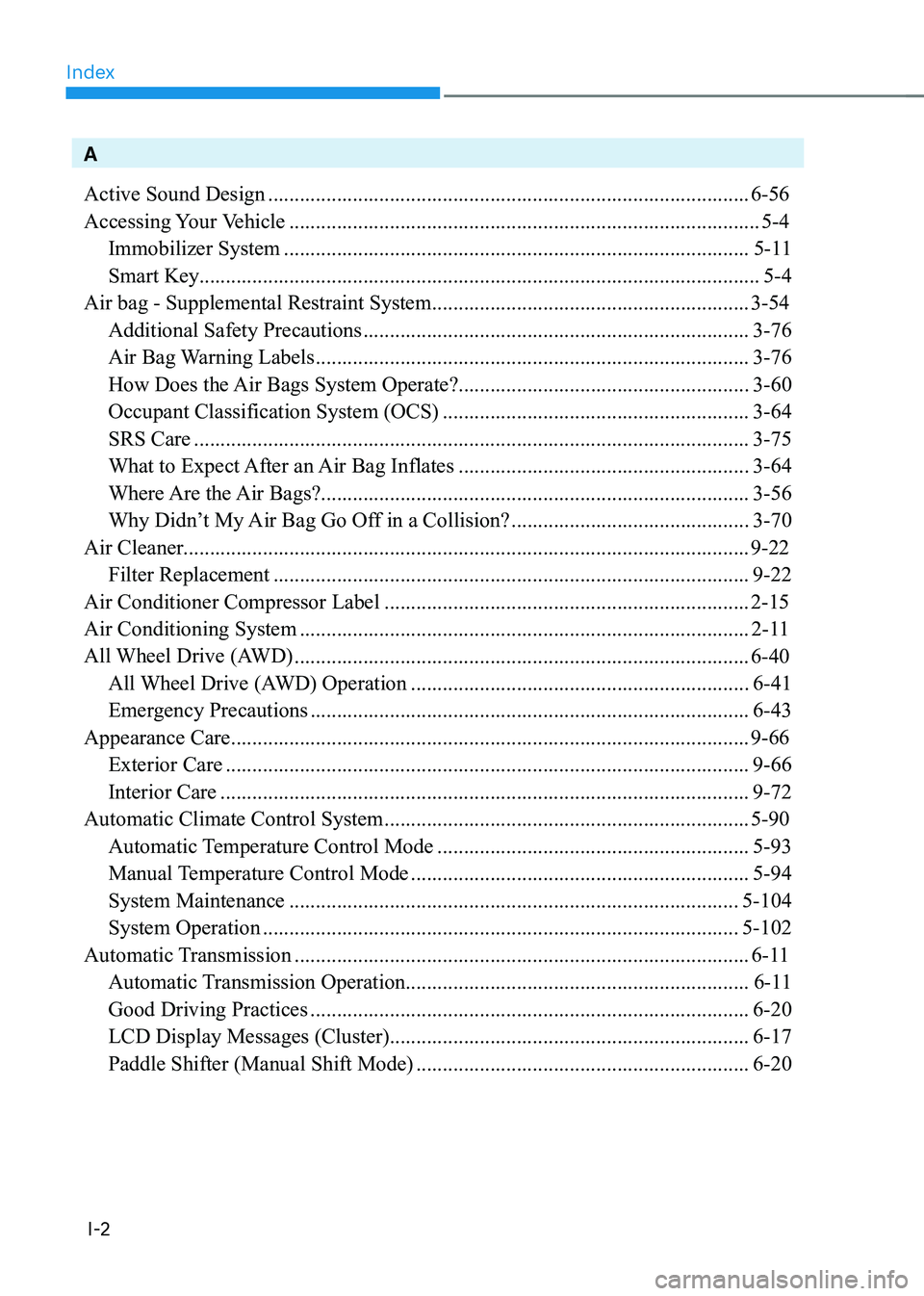
Index
I-2
A
Active Sound Design
........................................................................\
...................6-56
Accessing Your Vehicle
........................................................................\
.................5-4
Immobilizer System
........................................................................\
................5-11
Smart Key ........................................................................\
.................................. 5-4
Air bag - Supplemental Restraint System
............................................................3-54
Additional Safety Precautions
........................................................................\
.3-76
Air Bag Warning Labels
........................................................................\
..........3-76
How Does the Air Bags System Operate? .......................................................3-60
Occupant Classification System (OCS)
..........................................................3-64
SRS Care
........................................................................\
.................................3-75
What to Expect After an Air Bag Inflates
.......................................................3-64
Where Are the Air Bags? ........................................................................\
......... 3-56
Why Didn’t My Air Bag Go Off in a Collision?
.............................................3-70
Air Cleaner ........................................................................\
................................... 9-22
Filter Replacement
........................................................................\
..................9-22
Air Conditioner Compressor Label
.....................................................................2-15
Air Conditioning System
........................................................................\
.............2-11
All Wheel Drive (AWD)
........................................................................\
..............6-40
All Wheel Drive (AWD) Operation
................................................................6-41
Emergency Precautions
........................................................................\
...........6-43
Appearance Care
........................................................................\
..........................9-66
Exterior Care
........................................................................\
...........................9-66
Interior Care
........................................................................\
............................9-72
Automatic Climate Control System
.....................................................................5-90
Automatic Temperature Control Mode
...........................................................5-93
Manual Temperature Control Mode
................................................................5-94
System Maintenance
........................................................................\
.............5-104
System Operation
........................................................................\
..................5-102
Automatic Transmission
........................................................................\
..............6-11
Automatic Transmission Operation ................................................................. 6-11
Good Driving Practices
........................................................................\
...........6-20
LCD Display Messages (Cluster) .................................................................... 6-17
Paddle Shifter (Manual Shift Mode)
...............................................................6-20
Page 623 of 632
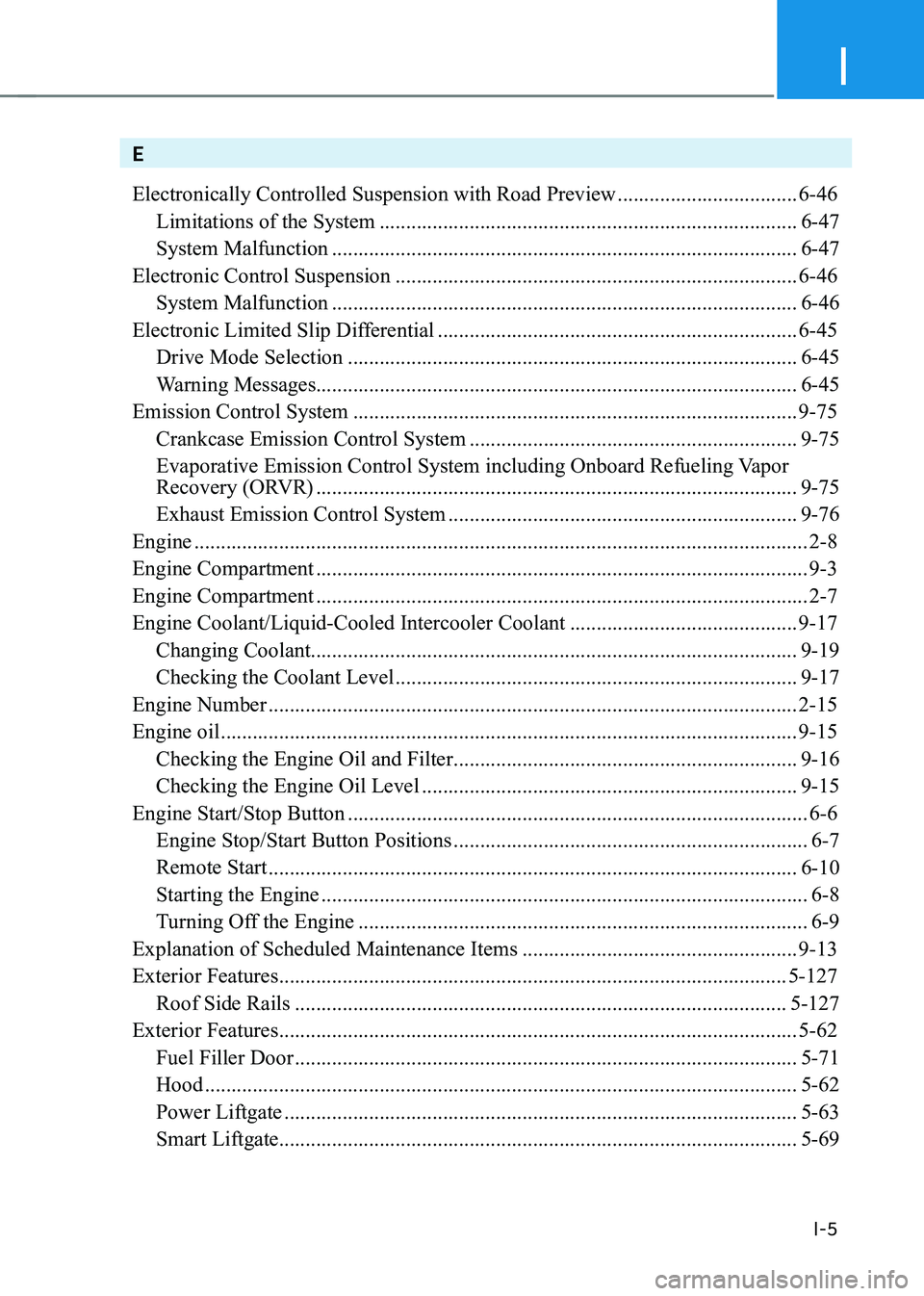
I
I-5
E
Electronically Controlled Suspension with Road Preview
..................................6-46
Limitations of the System
........................................................................\
.......6-47
System Malfunction
........................................................................\
................6-47
Electronic Control Suspension
........................................................................\
....6-46
System Malfunction
........................................................................\
................6-46
Electronic Limited Slip Differential
....................................................................6-45
Drive Mode Selection
........................................................................\
.............6-45
Warning Messages ........................................................................\
................... 6-45
Emission Control System
........................................................................\
............9-75
Crankcase Emission Control System
..............................................................9-75
Evaporative Emission Control System including Onboard Refueling Vapor
Recovery (ORVR)
........................................................................\
...................9-75
Exhaust Emission Control System
..................................................................9-76
Engine
........................................................................\
............................................2-8
Engine Compartment
........................................................................\
.....................9-3
Engine Compartment
........................................................................\
.....................2-7
Engine Coolant/Liquid-Cooled Intercooler Coolant
...........................................9-17
Changing Coolant ........................................................................\
.................... 9-19
Checking the Coolant Level
........................................................................\
....9-17
Engine Number
........................................................................\
............................2-15
Engine oil
........................................................................\
.....................................9-15
Checking the Engine Oil and Filter
.................................................................9-16
Checking the Engine Oil Level
.......................................................................9-15
Engine Start/Stop Button
........................................................................\
...............6-6
Engine Stop/Start Button Positions
...................................................................6-7
Remote Start
........................................................................\
............................6-10
Starting the Engine
........................................................................\
....................6-8
Turning Off the Engine
........................................................................\
.............6-9
Explanation of Scheduled Maintenance Items
....................................................9-13
Exterior Features
........................................................................\
........................5-127
Roof Side Rails
........................................................................\
.....................5-127
Exterior Features
........................................................................\
..........................5-62
Fuel Filler Door
........................................................................\
.......................5-71
Hood
........................................................................\
........................................5-62
Power Liftgate
........................................................................\
.........................5-63
Smart Liftgate ........................................................................\
.......................... 5-69
Page 624 of 632

Index
I-6
Exterior Overview (I) ........................................................................\
....................2-2
Exterior Overview (II)
........................................................................\
...................2-3
F
Forward Attention Warning (FAW)
.....................................................................7-63
System Malfunction and Limitations
..............................................................7-64
System Operation
........................................................................\
....................7-64
System Settings
........................................................................\
.......................7-63
Forward Collision–Avoidance Assist (FCA)
.........................................................7-2
System Malfunction and Limitations
..............................................................7-17
System Operation
........................................................................\
......................7-8
System Settings
........................................................................\
.........................7-5
Forward/Reverse Parking Distance Warning (PDW)
........................................7-125
System Malfunction and Precautions
............................................................7-130
System Operation
........................................................................\
..................7-128
System settings
........................................................................\
......................7-127
Fuses
........................................................................\
............................................9-44
Engine Compartment Panel Fuse Replacement
..............................................9-46
Fuse/Relay Panel Description
........................................................................\
.9-47
Instrument Panel Fuse Replacement
...............................................................9-45
G
Genesis Digital Key
........................................................................\
....................5-12
Digital Key (Card Key)
........................................................................\
...........5-19
Digital Key (Smart Phone)
........................................................................\
......5-12
Limitations of the System
........................................................................\
.......5-25
Personalized User Profile and Vehicle Settings
..............................................5-22
Used Vehicle/Digital Key Maintenance
..........................................................5-25
Guide to Genesis Parts
........................................................................\
...................1-3
H
Hazard Warning Flasher
........................................................................\
................8-2
Head-Up Display (HUD)
........................................................................\
.............5-74
Head-Up Display Information ........................................................................\
. 5-74
Head-Up Display Settings
........................................................................\
.......5-74
Precautions While Using the Head-Up Display
..............................................5-75
Page 628 of 632
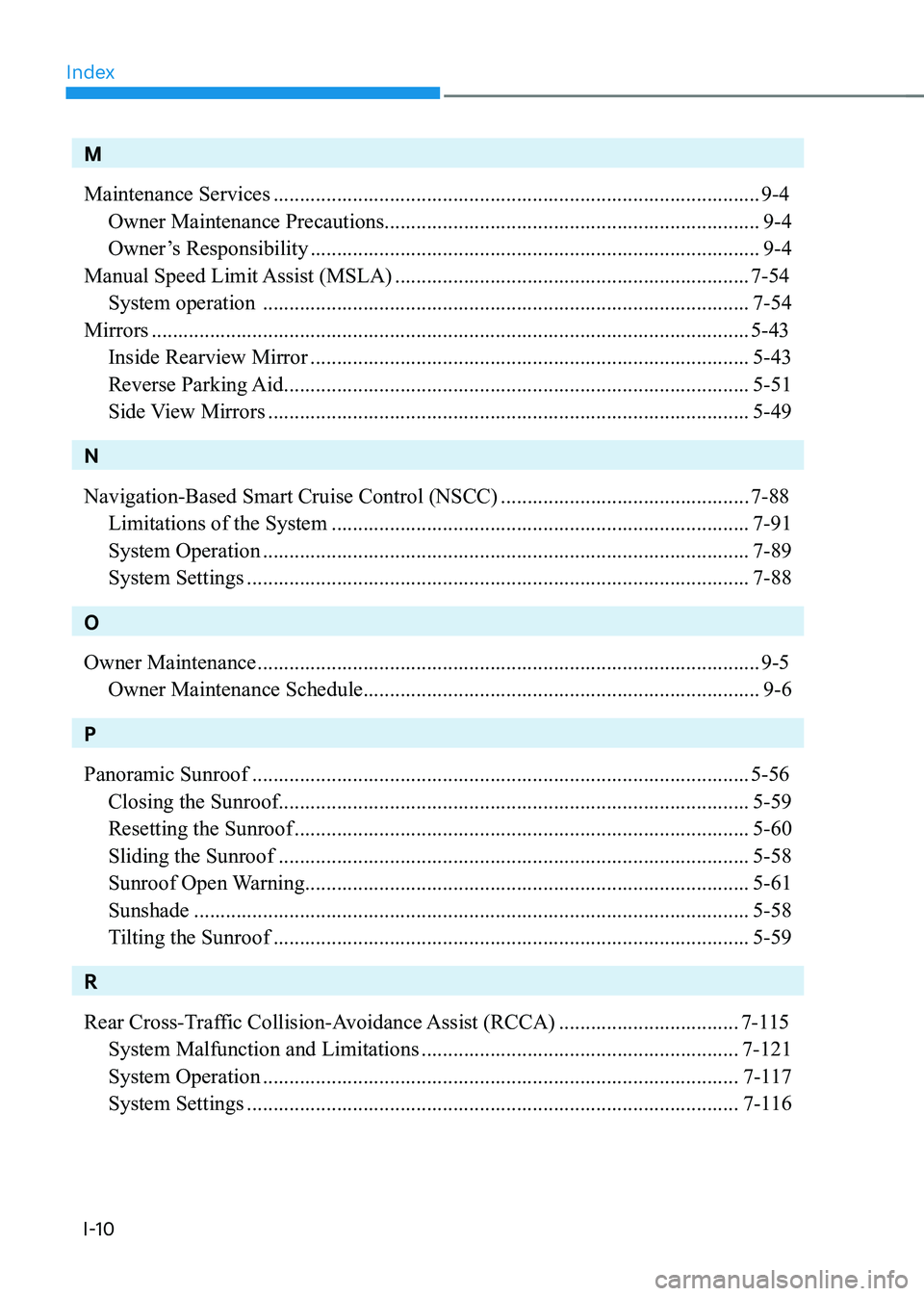
Index
I-10
M
Maintenance Services
........................................................................\
....................9-4
Owner Maintenance Precautions ....................................................................... 9-4
Owner’s Responsibility
........................................................................\
.............9-4
Manual Speed Limit Assist (MSLA)
...................................................................7-54
System operation
........................................................................\
....................7-54
Mirrors
........................................................................\
.........................................5-43
Inside Rearview Mirror
........................................................................\
...........5-43
Reverse Parking Aid
........................................................................\
................5-51
Side View Mirrors
........................................................................\
...................5-49
N
Navigation-Based Smart Cruise Control (NSCC)
...............................................7-88
Limitations of the System
........................................................................\
.......7-91
System Operation
........................................................................\
....................7-89
System Settings
........................................................................\
.......................7-88
O
Owner Maintenance
........................................................................\
.......................9-5
Owner Maintenance Schedule ........................................................................\
... 9-6
P
Panoramic Sunroof
........................................................................\
......................5-56
Closing the Sunroof ........................................................................\
................. 5-59
Resetting the Sunroof
........................................................................\
..............5-60
Sliding the Sunroof
........................................................................\
.................5-58
Sunroof Open Warning
........................................................................\
............5-61
Sunshade
........................................................................\
.................................5-58
Tilting the Sunroof
........................................................................\
..................5-59
R
Rear Cross-Traffic Collision-Avoidance Assist (RCCA)
..................................7-115
System Malfunction and Limitations
............................................................7-121
System Operation
........................................................................\
..................7-117
System Settings
........................................................................\
.....................7-116
Page 629 of 632
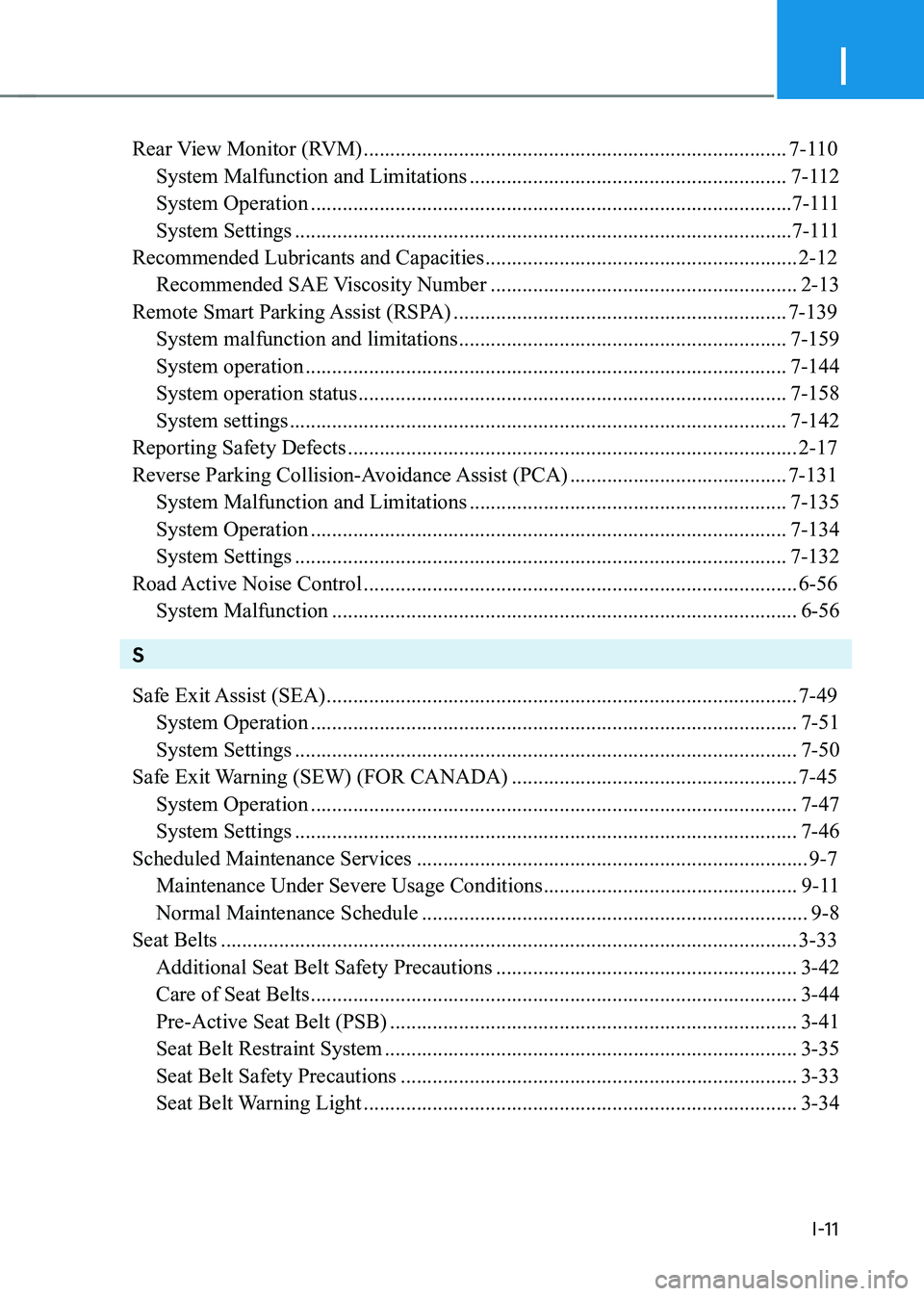
I
I-11
Rear View Monitor (RVM) ........................................................................\
........7-110
System Malfunction and Limitations
............................................................7-112
System Operation
........................................................................\
...................7-111
System Settings
........................................................................\
......................7-111
Recommended Lubricants and Capacities
...........................................................2-12
Recommended SAE Viscosity Number
..........................................................2-13
Remote Smart Parking Assist (RSPA)
...............................................................7-139
System malfunction and limitations
..............................................................7-159
System operation
........................................................................\
...................7-144
System operation status
........................................................................\
.........7-158
System settings
........................................................................\
......................7-142
Reporting Safety Defects
........................................................................\
.............2-17
Reverse Parking Collision-Avoidance Assist (PCA)
.........................................7-131
System Malfunction and Limitations
............................................................7-135
System Operation
........................................................................\
..................7-134
System Settings
........................................................................\
.....................7-132
Road Active Noise Control
........................................................................\
..........6-56
System Malfunction
........................................................................\
................6-56
S
Safe Exit Assist (SEA)
........................................................................\
.................7-49
System Operation
........................................................................\
....................7-51
System Settings
........................................................................\
.......................7-50
Safe Exit Warning (SEW) (FOR CANADA)
......................................................7-45
System Operation
........................................................................\
....................7-47
System Settings
........................................................................\
.......................7-46
Scheduled Maintenance Services
........................................................................\
..9-7
Maintenance Under Severe Usage Conditions
................................................9-11
Normal Maintenance Schedule
........................................................................\
.9-8
Seat Belts
........................................................................\
.....................................3-33
Additional Seat Belt Safety Precautions
.........................................................3-42
Care of Seat Belts
........................................................................\
....................3-44
Pre-Active Seat Belt (PSB)
........................................................................\
.....3-41
Seat Belt Restraint System
........................................................................\
......3-35
Seat Belt Safety Precautions
........................................................................\
...3-33
Seat Belt Warning Light
........................................................................\
..........3-34